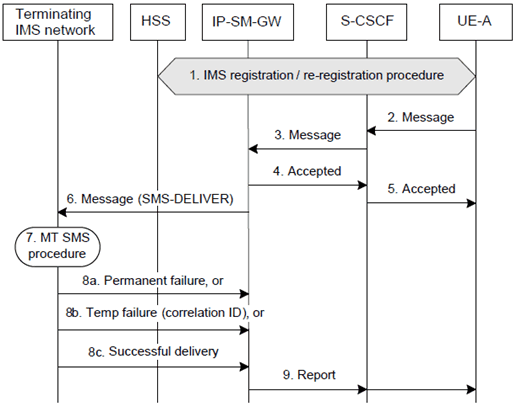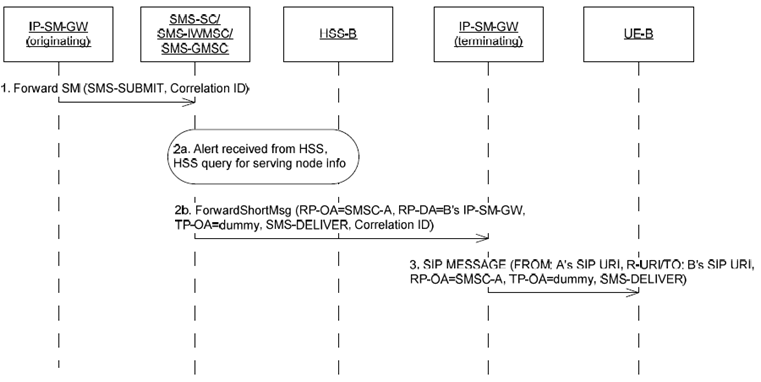Content for TS 23.204 Word version: 19.1.0
6.3a Transport-level interworking: Short Message origination procedure without MSISDN |R12| p. 19
6.3a.1 Initial delivery of SMS without MSISDN p. 19
Figure 6.3a.1 shows the initial SM delivery by IP-SM-GW during MO-SMS operation without MSISDN.

Figure 6.3a.1: Short Message origination procedure for MSISDN-less operation
(⇒ copy of original 3GPP image)
(⇒ copy of original 3GPP image)
Step 1.
The UE-A registers to S-CSCF according the IMS registration procedure. Note that I-CSCF and P-CSCF are not shown in this Figure.
Step 2.
UE-A submits the encapsulated Short Message (SMS-SUBMIT, SC Address) to the S-CSCF using an appropriate SIP method. Since recipient does not have MSISDN, the UE-A fills the TP-DA field with value that indicates recipient UE is addressed without MSISDN, and indicates recipient's SIP URI in SIP MESSAGE (e.g. UE-A sets the R-URI to PSI (SMSC address) and the To header with recipient's SIP URI in the MESSAGE). Based on the existing procedure, P-CSCF fills the UE-A's default URI to p-asserted-identity before sending the MESSAGE to S-CSCF.
Step 3.
S-CSCF forwards the encapsulated Short Message (SMS-SUBMIT, SC Address) to IP-SM-GW (AS) based on stored iFC.
Step 4.
IP-SM-GW (AS) acknowledges the SIP message.
Step 5.
SIP message acknowledge is forwarded by S-CSCF to UE-A.
Step 6.
The IP-SM-GW performs service authorization based on the stored subscriber data as described in the clause 6.1. The IP-SM-GW shall check whether the subscriber is authorised to use the short message service (e.g. Operator Determined Barring settings), similar to the authorization performed by MSC/SGSN in case the Short Message is delivered via CS or PS domain. In addition, the IP-SM-GW shall also check whether the user is authorised to use the encapsulated Short Message delivery via IMS. If the result of service authorization is negative, the IP-SM-GW shall not forward the message, and shall return the appropriate error information to the UE in a failure report. Otherwise, the IP-SM-GW (AS) extracts the Short Message (SMS-SUBMIT) and constructs the SMS-DELIVER and sends it towards the terminating IMS network.
Step 7.
The terminating IMS network tries to deliver the SM toward the designated recipient (see clause 6.4a).
Step 8.
Terminating IMS network response with one of the following:
Step 8a.
Terminating IMS network refuses or does not allow SMS delivery with MSISDN-less operation by sending back a permanent error.
Step 8b.
Terminating IMS network is not able to deliver the SM to designated recipient and returns a MSISDN-less correlation ID to allow retries at a later time. IP-SM-GW then forwards the SM to SMSC for storage and forward operation (see clause 6.3a.2).
Step 8c.
Terminating IMS network is successfully deliver the SM toward the designated recipient.
Step 9.
Proper response as determined in step 8a, 8b, or 8c is returned back to UE-A. For 8a, the response indicates to the UE-A that SMS to this recipient is failed permanently. For 8b, the response is the Submit report received from the SMSC. For 8c, the response indicates a successful delivery of the SM to the recipient.
6.3a.2 Subsequent re-delivery of SMS without MSISDN p. 20
When the initial delivery attempt failed and retry is possible (see Figure 6.3a.1 step 8b), the IP-SM-GW forwards the SM to SMS-SC for storage and forwarding operation. Figure 6.3a.2 shows the subsequent re-delivery attempt of SM by SMS-SC.

Step 1.
IP-SM-GW forwards the SM along with the MSISDN-less correlation ID received in step 8b of Figure 6.3a.1 to SMS-SC/SMS-IWMSC.
Step 2a.
SMS-SC/SMS-GMSC receives a trigger to re-deliver the SMS from HSS (see clause 6.5b) and queries the HSS for serving node information using the recipient's SIP URI and HLR-id from the MSISDN-less correlation ID.
Step 2b.
SMS-GMSC forwards the SM along with the MSISDN-less correlation ID to the IP-SM-GW using the address (i.e. IP-SM-GW of UE-B) received from HSS in step 2a.
Step 3.
IP-SM-GW (terminating) delivers SM to UE-B via the SIP MESSAGE.